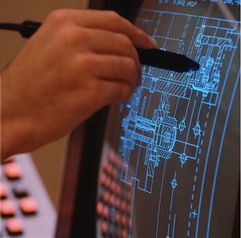What are Input Devices?
An input device is any peripheral (piece of computer hardware equipment) used to provide data and control signals to an information processing system (such as a computer).
Keyboard
A keyboard is an input device, partially modelled after the typewriter keyboard, which uses an arrangement of buttons or keys, which act as electronic switches. A keyboard typically has characters engraved or printed on the keys and each press of a key typically corresponds to a single written symbol. However, to produce some symbols requires pressing and holding several keys simultaneously or in sequence. While most keyboard keys produce letters, numbers or signs (characters), other keys or simultaneous key presses can produce actions or computer commands.

Application
- The keyboard is used to type text or numbers into a word processor, text editor or other program.
- Keyboards are also used for computer gaming, either with regular keyboards or by using special gaming keyboards, which can expedite frequently used keystroke combinations.
- A keyboard is also used to give commands to the operating system of a computer, such as Windows' Control-Alt-Delete combination, which brings up a task window or shuts down the machine.
Numeric keypad
A numeric keypad, or numpad for short, is the small, palm-sized, seventeen key section of a computer keyboard, usually on the very far right. The numeric keypad features
- digits 0 to 9,
- addition (+), subtraction (-),
- multiplication (*) and division (/) symbols,
- a decimal point (.) and
- Num Lock and Enter keys
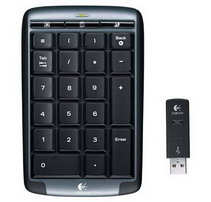
Application
Numeric keypads are useful for entering long sequences of numbers quickly, for example in spreadsheets, financial/accounting programs, and calculators. Input in this style is similar to that of a calculator or adding machine.
These are also used for inserting pin numbers for chip and pin credit/debit cards, or when using an ATM machine to withdraw money or check a bank balance.
Pointing Devices
A pointing device is an input interface (specifically a human interface device) that allows a user to input spatial (i.e., continuous and multi-dimensional) data to a computer. CAD systems and graphical user interfaces (GUI) allow the user to control and provide data to the computer using physical gestures — point, click, and drag — for example, by moving a hand-held mouse across the surface of the physical desktop and activating switches on the mouse. Movements of the pointing device are echoed on the screen by movements of the pointer (or cursor) and other visual changes.
Few common pointing devices are:
- Mouse used in most PCs
- Touchpad usually found on Laptop computers
- Trackerball is used by people with limited motor skills e.g. young children or people with disabilities.
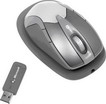 |  |
Remote Controls
Commonly, remote controls used to issue commands from a distance to televisions or other consumer electronics such as stereo systems and DVD players. Remote controls are extensively used to operate TVs, video players/recorders, DVD players/recorders, satellite receivers, Hi-Fi music systems, data or multimedia projectors.
Most of these remotes communicate to their respective devices via infrared (IR) signals and a few via radio signals.
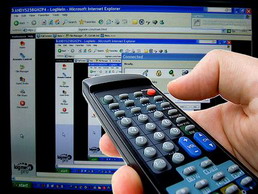

Joystick
A joystick is an input device consisting of a stick that pivots on a base and reports its angle or direction to the device it is controlling.

Application
- Joysticks are often used to control video games, and usually have one or more push-buttons whose state can also be read by the computer.
- The joystick has been the principal flight control in the cockpit of many aircraft, particularly military fast jets.
- Joysticks are also used for controlling machines such as cranes, trucks, underwater unmanned vehicles and zero turning radius lawn mowers.
- Miniature finger-operated joysticks have been adopted as input devices for smaller electronic equipment such as mobile phones.
Touch Screen
A touch screen is a display which can detect the presence and location of a touch within the display area. The term generally refers to touch or contact to the display of the device by a finger or hand. Touchscreens can also sense other passive objects, such as a stylus. In short, the ability to interact directly with a display typically indicates the presence of a touchscreen.
The touchscreen has two main attributes.
- First, it enables one to interact with what is displayed directly on the screen, where it is displayed, rather than indirectly with a mouse or touchpad.
- Secondly, it lets one do so without requiring any intermediate device, again, such as a stylus that needs to be held in the hand.
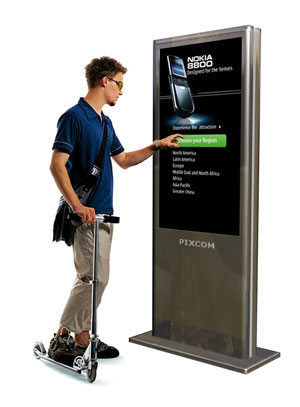
Application
- Usually touch screens are found in certain POS uses such as cafes, tourist information kiosks, public transport enquiries.
- They also play a prominent role in the design of digital appliances such as the personal digital assistant (PDA), satellite navigation devices and mobile phones.
Find more information how touchscreen works
Magnetic stripe readers
Magnetic stripe readers are devices that are utilized to allow the encoded information contained in the magnetic stripe that is found on the back of credit, debit, and other types of payment cards. The reader makes it possible for vendors to accept the cards for payment and quickly complete the transaction.
The magnetic stripe reader may scan and read detail such as the account number and expiration date for the card and the name of the cardholder.
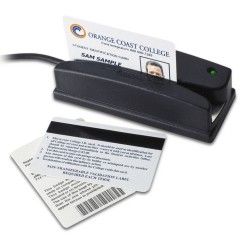
You will usually find these gadgets at Point of sales terminals, ATMs. Many times Magnetic stripe readers are used to validate entry of authorised personnel into a building.
PINpad
A PINpad is an electronic device used in a debit or smart card-based transaction to input and encrypt the cardholder's PIN.
Pinpads are normally used with integrated point of sale devices in which the Electronic Cash Register (ECR) machine is responsible for taking the sale amount and initiating/handling the transaction. The PinPad is just available so that the customer card can be accessed and the pin can be encrypted before it is sent upstream to the transaction manager of the switch or the bank.
Like the stand-alone point of sale devices, PinPads are also equipped with hardware security features so that the injected security keys are erased if someone tries to tamper with the device. Also the encrypted PinBlock is stored in an internal register for only a very small period of time (in milliseconds) during which the ECR application can request it.
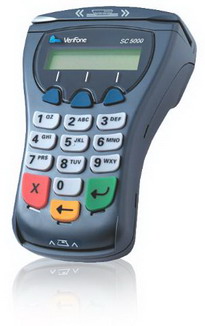
Apart from paying you bills at the store, PINpad is also used in ATMs to obtain cash.
Scanner
A scanner optically scans images, printed text, handwriting, or an object, and converts it to a digital image.
Common examples found in offices are variations of the desktop (or flatbed) scanner where the document is placed on a glass window for scanning.

Digital cameras
A digital camera is a camera that takes video or still photographs, or both, digitally by recording images via an electronic image sensor.
Many compact digital still cameras can record sound and moving video as well as still photographs. Digital cameras can do things film cameras cannot: displaying images on a screen immediately after they are recorded, storing thousands of images on a single small memory device, recording video with sound, and deleting images to free storage space.
Digital cameras are incorporated into many devices ranging from PDAs and mobile phones (called camera phones) to vehicles.
The Hubble Space Telescope and other astronomical devices are essentially specialised digital cameras.
Taking photographs for input to computers, for input to Photo printers
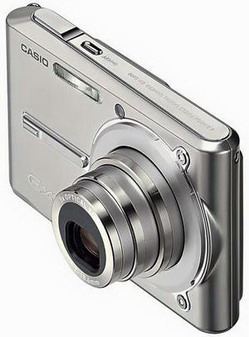
Find out more about Digital Cameras
Microphones
A microphone is an acoustic-to-electric transducer or sensor that converts sound into an electrical signal.
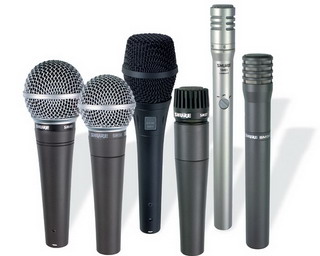
Application
Microphones are used in many applications such as telephones, tape recorders, hearing aids, motion picture production, live and recorded audio engineering, in radio and television broadcasting and in computers for recording voice, VoIP, and for non-acoustic purposes such as ultrasonic checking.
When using with a computer it can be used for recording of voices for presentation software.
Sensors (general)
A sensor is a device that measures a physical quantity and converts it into a signal which can be read by an observer or by an instrument.
Applications include cars, machines, aerospace, medicine, manufacturing and robotics.
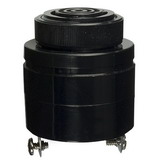
Common types of Sensors
Temperature sensors are commonly used in automatic washing machines, automatic cookers, air conditioning controllers, central heating controllers, computer-controlled greenhouses, scientific experiments and environmental monitoring.
Pressure sensors are used in Burglar alarms, automatic washing machines, robotics, production line control, scientific experiments and environmental monitoring.
Light sensors are used in computer controlled greenhouses, burglar alarm systems, robotics, production line control, scientific experiments and environmental monitoring
Graphics tablet
A graphics tablet (or digitizing tablet, graphics pad, drawing tablet) is a computer input device that allows one to hand-draw images and graphics, similar to the way one draws images with a pencil and paper. These tablets may also be used to capture data of handwritten signatures.
A graphics tablet (also called pen pad) consists of a flat surface upon which the user may "draw" an image using an attached stylus, a pen-like drawing apparatus. The image generally does not appear on the tablet itself but, rather, is displayed on the computer monitor. Some tablets however, come as a functioning secondary computer screen that you can interact with directly using the stylus.
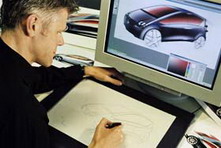
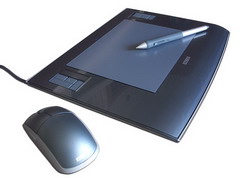
Some tablets are intended as a general replacement for a mouse as the primary pointing and navigation device for desktop computers.
Magnet Ink Character Reader
A magnetic character reader system for reading and identifying magnetized characters printed on a document such as a Bank cheque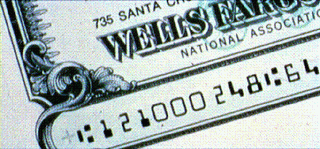
To input magnetic characters, such as those found on bank cheques
Advantage: A quick and reliable way of imputing large volume of simple data
Disadvantage: Can't be used for bulk text/numbers input.
Optical Mark Reader
A special scanning device that can read carefully placed pencil marks on specially designed documents.

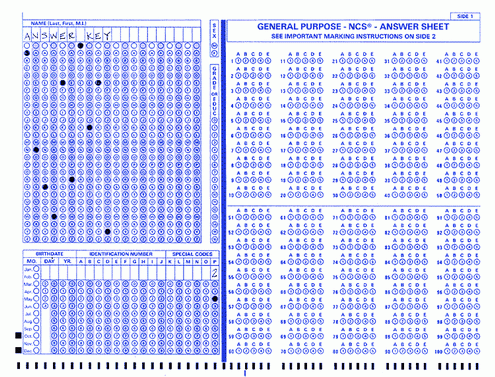
Sample Stationery used by OMR
Application
OMR is frequently used in forms, questionnaires, and answer-sheets.
Other practical applications include inputting pencil marks on a form such as a school register, candidate exam answers, any application involving input of a choice of options.
Optical Character Reader
OCR (optical character recognition) is the recognition of printed or written text characters by a computer. This involves photo scanning of the text character-by-character, analysis of the scanned-in image, and then translation of the character image into character codes, such as ASCII, commonly used in data processing.
Application
OCR is being used by libraries to digitize and preserve their holdings. OCR is also used to process checks and credit card slips and sort the mail. Billions of magazines and letters are sorted every day by OCR machines, considerably speeding up mail delivery.
Bar code Reader
A barcode reader, also called a price scanner or point-of-sale ( POS ) scanner, is a hand-held or stationary input device used to capture and read information contained in a bar code . A barcode reader consists of a scanner, a decoder (either built-in or external), and a cable used to connect the reader with a computer. Because a barcode reader merely captures and translates the barcode into numbers and/or letters, the data must be sent to a computer so that a software application can make sense of the data.
A barcode reader works by directing a beam of light across the bar code and measuring the amount of light that is reflected back. (The dark bars on a barcode reflect less light than the white spaces between them.) The scanner converts the light energy into electrical energy, which is then converted into data by the decoder and forwarded to a computer.
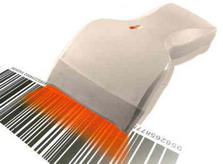
To input code numbers from products at a POS terminal, library books and membership numbers
Video Camera

To input moving pictures, often pre-recorded, pre-recorded, into a computer
Web cam
To input moving pictures from a fixed position into a computer
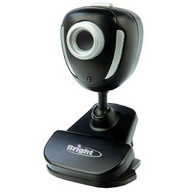 |
Light pen
Where desktop space is limited, it is used Instead of a mouse or for drawing applications where a graphics tablet might be too big.